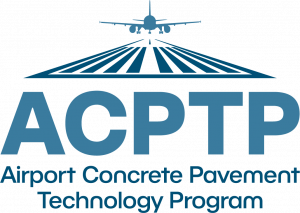Upcoming Projects
The following are a list of current applied research needs related to concrete pavement airfields. This is only a partial list and is subject to change through discussion with the ACPTP program coordination group and/or technical advisory committee.
ACPTP- Load Transfer in Concrete Pavement
Current FAA and Department of Defense (DoD) standards for airfield pavement are designed for aggregate interlock to provide load transfer in contraction control joints except for the last three joints at the end of a feature or adjacent to an isolation joint. The airfield pavement design assumptions include a 25 percent load transfer across the pavement joints. The FAA and DoD assume that aggregate interlock will provide for at least the design assumption for load transfer. However, many engineers question if this assumption is valid during concrete contraction in cold weather or after numerous expansion and contraction cycles. Research has shown that edge stress increases under load and that the dowels provide increased load transfer efficiency. However, in some cases the concrete deflection under load was small, therefore the dowels did not engage. So, the question remains, does doweling all contraction joints increase pavement performance enough to justify the increased cost of installing dowels in all contraction joints. Applied research is needed to assess the performance and value of dowelled versus un-dowelled contraction joints.
ACPTP- Acceptance Criteria
A common dispute on a construction site involves the interpretation of specification requirements or enforcement of requirements that may not be required to achieve system performance in every situation
A typical example is the acceptance criteria for strength. Many engineers argue that because the mechanical failure mode of slabs on grade is in flexure, then acceptance should be based on testing this parameter. On the other hand, sample sizes and the difficulty of achieving an accurate result pose safety and uniformity concerns, whereas correlation with the more reliable compression test may achieve a better outcome. Confounding the idea that many engineers assume the sample is representative of the in-place concrete is that samples extracted from the concrete usually exhibit different results from samples prepared at the time of placement and stored under controlled conditions. Moreover, some engineers and constructors argue that maturity or other methods may be a better and more reliable option to confidently accept in-place concrete pavement strength as meeting specification requirements. This topic has been extensively researched in the past, but more work is needed to develop protocols and practices that are fair and minimize risk to all parties involved.
Planned work to address these types of issues includes:
- Interview owners, engineers, and contractors to develop a list of the most common specification provisions that cause disputes.
- Conduct research to find solutions to these ambiguous specification provisions.
- Prepare language to insert into specifications to clarify and resolve such problems.
The result of this may lead to further research to develop new acceptance criteria that will lead to better pavement performance at a reduced cost due to unnecessary disputes.
ACPTP- Concrete Pavement Resilience (Temperature Effects)
As environmental temperatures continue to increase, the relative movements of concrete pavement on the grade may exceed the tolerances that can be accommodated by current design practices and specification requirements. The risk of pavement distresses such as shoving, joint damage, and buckling is currently growing and may continue to increase thereby compromising pavement performance and increasing maintenance costs. Therefore, research must be conducted to:
- Predict how much movement may be expected due to thermal changes in a global warming environment.
- Develop ideas on how these movements can be accommodated in new and existing pavements.
- Develop recommendations for design guidance to implement preventative actions to minimize the risk of pavement failures.
ACPTP- Design Procedures for Low Carbon Cements
With increasing pressure to reduce the carbon footprint of the concrete construction industry, cement manufacturers are developing new products such that cement clinker can be replaced with alternative materials like calcined clay, limestone, and pozzolans. These materials will likely exhibit performance differences in concrete pavement in terms of:
- Set Time
- Air entrainment
- Bleeding
- Strength gain
- Modulus of elasticity
- Permeability
- Sulfate expansion
- Calcium oxychloride resistance
- Shrinkage
New protocols are needed to consistently characterize individual products and their impacts on concrete pavements. In addition, pavement structural models, design procedures, construction practices, and acceptance limits need to be modified to accommodate the differences. Research is needed to address these issues and to assess if recommended and appropriate changes are needed to FAA Advisory Circulars.

